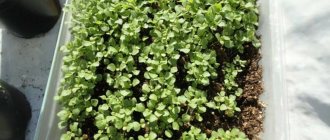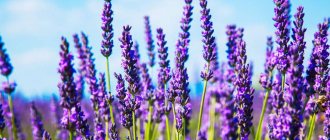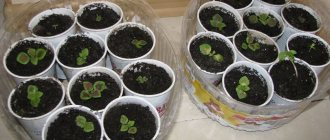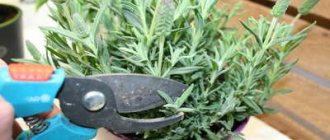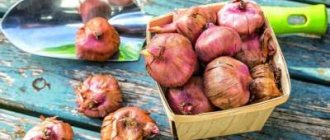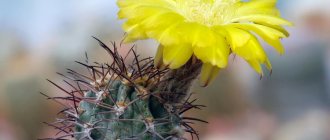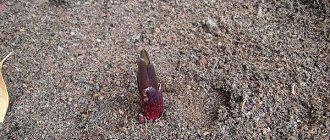In recent years, many flower growers have started growing lavender in their dachas and private home areas. And this is not at all surprising - the soft lilac flowers and aroma in the garden evoke boundless admiration. Next you will find detailed information about growing the crop through seedlings, a guide with photographs on sowing lavender and stratifying the seed.
What does it mean?
Since the seeds of some plants go into a state that resembles animal hibernation during the winter, they need to be immersed in conditions close to natural so that they sprout in the spring.
You can simulate this process at home , which will allow more seeds to come to life at the right time. Lavender seeds also need this manipulation.
Attention ! Stratification is the process of keeping seeds at a certain temperature for a long period of time to speed up their germination after planting.
The procedure allows you to achieve the following results:
- increasing the number of quality seeds from which flowers can be grown;
- hardening of the seed, which helps strengthen the plant’s immunity and its resistance to changeable weather conditions.
Thus, stratification is a kind of imitation of the winter period with gradual (spring) warming , which awakens the seeds and stimulates the growth and development of the plant.
Stratification is not required for those crops whose homelands are considered to be southern regions where there are no severe frosts. Plants whose seeds ripen in the first half of summer do not need this procedure. For these crops, it is enough to soak the planting material for a day in warm water.
As for lavender, stratification of its seeds is extremely necessary, since otherwise there will be no shoots or the sprouts will be weak and non-viable .
Seedling care
Young lavender seedlings from seeds should be in a warm and very bright place. The temperature should be at 19-23 degrees. Natural or artificial light (special phytolamps should be used) should illuminate young seedlings for at least 8 hours daily. Under such conditions, the stem will not stretch, and the plant will form stronger.
Until the real leaves appear, lavender seedlings should be kept in bright light at a temperature of 18-22 degrees. It should be watered carefully so as not to create favorable conditions for the development of fungi. Seedlings do not need shading, since in the absence of sun, fungi and mold may appear. Lavender itself tolerates bright sunlight well.
When 2-3 true leaves appear, the seedlings need to be transplanted into individual pots with a diameter of about 5-7 cm. The soil for plants should be made up of equal parts of turf and leaf soil, peat, and coarse sand. If necessary, you can add perlite granules and coconut fiber.
You need to replant plants like this:
- Fill the new container 2/3 full with soil and make a hole in the middle.
- Carefully remove the lavender sprout from the tray with a lump of soil.
- Place the plant in the pot so that the roots take a vertical position. There should be no bends!
- Gently pour water over the roots to completely straighten them.
- Cover the roots of the plant and part of the stem with soil. It is important to ensure that the central bud remains on the surface.
The soil must be compacted carefully, without excessive pressure. Next, the plant is watered with a small amount of water, exposed to light, and the temperature is maintained at 15-20 degrees.
Growing lavender seedlings require care in the form of periodic feeding. It is advisable to periodically water it with a weak solution of mineral fertilizers for flowers. This should be done after watering. A good option is to fertilize the soil directly with slow-soluble granular fertilizers. However, you need to be extremely careful with them. If there is an excess of nutrients, lavender roots run the risk of severe burns.
IMPORTANT
You need to water lavender seedlings after the clod of soil has dried out!
When should you start?
This procedure is quite time-consuming.
On average it takes about 1.5 months. It turns out that you need to start preparing lavender seeds for planting in January-February. The timing of sowing seedlings serves as a guide. If you plan to start planting in March, then the optimal time to start stratification is the end of January. A more exact date depends on the region :
- Moscow region and central Russia - January 15-20;
- southern regions - the first days of January;
- Ural, Siberia, Far East - the first days of February.
Stratification usually takes from 30 to 40 days.
Further preservation of lavender: preparation for winter
Lavender, which began to bloom in mid-July, bloomed in our flower garden until the end of October. At the end of October, on the eve of the onset of frost, lavender should be cut back to the woody part, mulched and left to overwinter. Now it is already an adult bush, which every year will grow and bloom more actively and en masse.
Two-year-old lavender angustifolia bush, prepared for winter
Read our special material on how to properly prepare lavender for winter>>>
Watch a video about growing lavender from seed to flowering bush: very short
Under what conditions is it carried out?
Lavender seeds do not germinate without preliminary preparation, so they need to be “shaken.” To do this, gardeners use several methods, but more often the procedure is carried out at home, using cold or heat .
In some cases, the method of natural stratification is used, but it does not always give a positive result. To do this, you need to sow lavender seeds in a seedling bed before winter. For obvious reasons, this method is not suitable for regions with severe winters, unexpected thaws, and recurrent frosts without snow.
This is why experienced gardeners prefer to carry out stratification at home. To do this, you can use the refrigerator , having previously placed the planting material in a humid environment, as well as warming the lavender seeds in hot water for 10-15 minutes.
Basic Rules
The stratification procedure should not scare novice gardeners. It is enough to follow the basic rules and take into account some nuances:
If you choose the sawdust method, it is important to stir them periodically.- When not only lavender seeds, but also other plants, are hardened in the refrigerator, it is necessary to label each jar or bag so that there is no confusion when planting the seed.
It is important to indicate the start date of hardening and other information that will be useful.
- Lavender seeds should be placed on the shelf in the refrigerator that is closest to the freezer, since it is coldest there. In this case, the optimal storage temperature should remain within 3-5°C.
- It is recommended to stratify seeds in agroperlite, since it retains moisture well. It can be used either alone or mixed with sand.
- After the hardening procedure, the seeds should be kept in a solution of the Epin drug.
- The specified stratification periods cannot be reduced, as this will negatively affect the degree of development of lavender during the period of the first shoots.
- Exceeding and lowering the temperature is extremely undesirable. In the first case, the seeds may germinate, but in the second, they may die.
Important ! A key part of lavender stratification is maintaining a moist environment. To do this, the material must be constantly moistened.
Can it be grown?
Propagation by seeds for flowers, and in our case for lavender, is not only a traditional method, but also does not have any reservations or warnings .
Equally brightly characteristic of both annuals and perennials, which is lavender.
In addition, mature bushes produce their own seeds, in large quantities, and the quality is often no worse than purchased ones.
If self-seeding is used, then this is the most economical option among all possible , although at the same time, if the mother bush grows in not particularly high-quality conditions, the decorative properties of the plant may be somewhat reduced. Seed propagation is so common that when planting lavender it is often meant by default.
If we compare the effectiveness of the considered reproduction option with other methods, then it is among the leaders in terms of effectiveness. No worse than dividing the bush and using layering and, obviously, better than cuttings, since with it the branches do not always produce roots.
How to stratify at home?
There are three main ways to stratify in the cold. You should choose the most suitable and convenient one :
- on cotton pads;
- on sawdust;
- on the sand.
Each of them has its pros and cons.
On cotton pads
It is believed that this is the simplest and most understandable way to stratify lavender seeds. The procedure algorithm is as follows :
- Take one cotton pad and divide it into two parts to create a top and bottom layer.
- Sprinkle lavender seeds on one half and cover with the other.
- Place the disc on a saucer and moisten the disc using a spray bottle. This way the moisture will be distributed evenly.
- Place the disc in a bag or glass container.
- Leave on the table for about a day. After this, transfer to the refrigerator.
Next, you need to monitor the disc and make sure it does not dry out. It needs to be moistened periodically.
On sawdust
For this method, you should prepare clean sawdust in advance. The sequence of actions is as follows :
Pour boiling water over the sawdust.- Cool and then squeeze out excess moisture.
- Mix them with lavender seeds.
- Transfer to a glass jar or plastic bottle.
- Leave for three days at room temperature.
- Place in the refrigerator.
Attention ! There should be approximately twice as much sawdust as seeds.
On the sand
This method requires clean sand. The procedure algorithm is as follows :
- Mix lavender seeds with plenty of clean sand.
- Moisten thoroughly.
- Transfer to a suitable container and close tightly with a lid or film.
- It must be kept at room temperature for a day, and then put in the refrigerator.
The sand needs to be moistened as needed, but there is no need to over-moisten it , since the seeds may rot.
Possible difficulties and errors
First of all, you need to pay attention to high-quality seed material. If the lavender seeds are not trustworthy, then most likely the sprouts will not appear. In this case, even stratification will not help.
When purchasing, you need to check the integrity of the packaging : there should be no dents, damage or tears.
You should find labeling with a description of the variety, recommendations, and expiration date of the seeds. They must be intact, identical in size, without stains or the smell of mold. If the seed is cheap compared to competitors, then it is more likely to be of poor quality.
You should take seeds from a trusted manufacturer.
It is important to strictly follow all recommendations regarding timing and temperature conditions , otherwise the lavender seeds will not undergo stratification and there will be no seedlings after planting.
Carefully ! The decrease in temperature of planting material after stratification should be smooth.
If a method using sand is used, it must be disinfected . If you do not do this in time, before the procedure, you may later find mold in the container with the seeds. The problem is easily solved: you need to take any suitable fungicide and treat the sand.
Another common problem: lavender seeds sprouted in the refrigerator. For a while, you need to open the containers and expose the planting material to light, for example, to a window. In this case, the seedlings will outgrow a little, but after planting they should return to normal.
Advantages and disadvantages
Stratifying lavender seeds at home has the following advantages:
- has a positive effect on the rate of seed germination;
- allows you to achieve friendly shoots;
- lavender seeds awaken faster from hibernation;
- future flowers are resistant to changeable weather;
- the stratification procedure affects the production of more primordia;
- Plants show strong immunity and can resist diseases and insect pests.
There are no downsides to stratifying lavender seeds, since this is a necessary procedure for this crop. Without it, planting material will not sprout. Therefore, it makes no sense to talk about whether it is worth carrying out in relation to a given plant.
Possible disadvantages include only an incorrectly performed procedure . That is why experienced gardeners recommend adhering to the basic rules.
Advice! If stratification is carried out for the first time, it is better to use the method on cotton pads. It is considered to be the simplest and most effective.
How long does it take to sprout after the procedure?
So that the first shoots do not have to wait long, and the seedlings show good health, it is necessary to provide them with high-quality care.
If you regularly and properly care for the seedlings, the first shoots will appear in about two weeks . On average, lavender seeds germinate within a month.
However, despite the successful stratification, good care of the emerging sprouts will be required, otherwise all efforts will be in vain. Lavender seedlings need to be provided with:
- proper watering regime;
- placement on the sunny side of the room;
- additional lighting in the form of a special lamp;
- optimal temperature in the room at night and during the day;
- sudden changes in temperature during the day should not be allowed;
- daily ventilation.
At a certain period, seedlings will need to be planted . Transplantation into open ground should take place in May. The exact date varies by region.
Important ! For lavender, soil with a neutral or slightly alkaline reaction is most preferable. If the soil on the site is acidic, it is recommended to add dolomite flour or wood ash.
Where to plant lavender in your summer cottage
Lavender is planted where it is convenient for the owner of the site (along paths, on alpine hills, as a hedge), sometimes even lavender fields are arranged. But in order for growth and flowering to be complete, the planting site must be sunny, not flooded with rain, and not damaged by groundwater. They try to choose a place on a hill, away from tall trees and buildings that create shadow. The southern and southwestern slopes are good. The plant is not afraid of scorching sunlight.
To create the maximum decorative effect, you need to take into account the size of an adult bush. Most varieties require a considerable area: 3-4 plants per square meter. If the bushes are planted individually, you need to allocate at least 0.5 m2 for each.
Often, rows of lavender are alternated with rows of other flowers or herbs, but the choice is limited: they must be drought-resistant and not afraid of the scorching sun.
Tricks and Tips
Experienced gardeners advise when growing lavender:
- use growth stimulants (Kornevin or Epin) to treat seeds before sowing;
- do not try to sow without stratification;
- keep containers with seedlings on the southern windowsill, but still illuminate them in the morning and evening with phytolamps;
- Place piles of large stones next to the lavender plantings in the garden: they smooth out the difference between day and night temperatures, accumulating and then releasing thermal energy;
- in regions that are not the warmest, cover the plantings for the winter, but do not be late in removing the cover in the spring;
- watering should be carried out only in the early morning or late evening;
- Do not plant lavender next to moisture-loving crops.
The best neighbors for lavender are considered to be herbs (basil, oregano, sage, etc.), the worst are fruit and berry bushes.
Lavender is a fragrant, heat-loving plant with healing properties. Caring for her is not difficult. The flower is grown from seeds through the seedling stage. Lavender is an ornamental crop located in sunny places, often on alpine hills. It is interesting both in the appearance of flowering plants and in its stunning aroma, which calms the nervous system.



